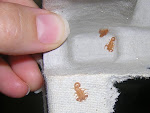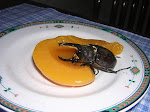Though I do not know what pest management actions the hospital requested, my urban entomology experience tells me it likely wasn't the IPM option.
The hospital suggests the cockroaches were accidental invaders due to disturbance from nearby
 construction. Sounds plausible. Given this, I hope their pest expert/company had enough integrity to resist a knee-jerk reaction to spray pesticides inside the hospital first and ask questions later. Ideally, the hospital requested IPM services. This means assessing the level of pestiness first with a thorough inspection, monitoring traps, and questions for staff about roach activity. What would have followed from that: proper identification of any found cockroaches, followed -- again, ideally -- by pest proofing (e.g., door sweeps) and minor habit changes among the staff to discourage pests (e.g., waste management). To cap it off: monthly service calls thereafter from their pest professional to inspect the insect monitoring traps for roach activity and make further recommendations for structural improvements or modified habits as needed. Only if an infestation were found would pesticides be needed, and even then only as an initial knock-down. This is good IPM; long term solution, minimal pesticides used and minimum risk to human health.
construction. Sounds plausible. Given this, I hope their pest expert/company had enough integrity to resist a knee-jerk reaction to spray pesticides inside the hospital first and ask questions later. Ideally, the hospital requested IPM services. This means assessing the level of pestiness first with a thorough inspection, monitoring traps, and questions for staff about roach activity. What would have followed from that: proper identification of any found cockroaches, followed -- again, ideally -- by pest proofing (e.g., door sweeps) and minor habit changes among the staff to discourage pests (e.g., waste management). To cap it off: monthly service calls thereafter from their pest professional to inspect the insect monitoring traps for roach activity and make further recommendations for structural improvements or modified habits as needed. Only if an infestation were found would pesticides be needed, and even then only as an initial knock-down. This is good IPM; long term solution, minimal pesticides used and minimum risk to human health.One would think that particularly in this case (hospital, sick people, pregnant women, newborn babies) IPM would be a no-brainer. But for reasons I can only chalk up to lack of awareness, I see the opposite happen all the time. People choose the traditional option - hose it now, ask questions later. "Spray and pray" is another term of endearment. But when panic sets in -- and public sympathy for a pregnant woman over a "dirty" hospital is excellent fodder for controversy-driven panic -- the customer usually requests a lid on the eco-bright ideas for the PR-assuaging approach of spray (!). Ironically, everyone assumes that if pesticides are applied, the problem is taken care of. Everyone feels better.
IPM methods are not only eco-friendly and human-health-friendly, but the technique also demonstrates significant reduction in pests over the hose-and-go approach. Not embracing this is, well, a loss of opportunity for some great PR at the very least. THAT'S what this story should have been about (i.e., "Hospital addresses patient health with progressive pest control").
Ah, well. Hope they dealt with those 2 cockroaches.
********
Addendum, 2.23.08: Coincidentally, NPR aired a story yesterday about a fleet of Turkmenistan newscasters being fired by the country's President because a cockroach was a repeat visitor on the set. Assuming the almost unbelievable story is true, it makes absolutely no sense. I wouldn't even know where to begin addressing this in a post, except to say: 1. How did he get into office? 2. Good thing this didn't happen in Turkmenistan.
+reduced.jpg)


No comments:
Post a Comment